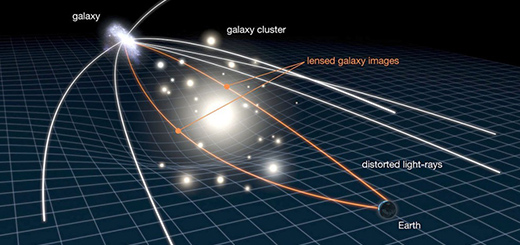Gravitational lensing is one of the interesting phenomena in the universe. It suggests that, the presence of matter or in other words, energy density can curve space-time, and the path of a light ray can be deflected as a result. In more detail, in the presence of a gravitational field, the direction of the light rays passing through will be altered because of the strength of the gravitational field. Many useful results for cosmology have come out of using this property of matter and light. The interesting part the process creates is, creation of illusions which are interesting to observe.
Cosmology is a branch of astronomy, which discusses the birth, the evolution and the future of the universe. Humans have been asking questions like, what the universe made of, how it formed, how old is it, etc. But it was only in the near past that our understanding of the universe could have an idea about those questions.

This chart shows total mass-energy content of the universe. Einstein’s theories suggest that energy is neither created nor destroyed, which gives the idea that matter can be converted to energy. Mass is just a measure of internal energy content of an object. All the regular matter in the universe, which is also known as the baryonic matter which makes up galaxies, planets, stars, nebulae, interstellar medium only makes up, only 4% of the mass-energy content of the universe. Which makes the most of the universe is dark matter and dark energy. Dark matter and dark energy is so named because cosmologists do not know what they actually are and we cannot see them directly. But we can only predict their existence by the effect of them on the regular matter that we can see. So it suggests that most of the universe is invisible and unknown to us.
The principle behind gravitational lensing is the bending of light, or more accurately bending of any kind of electromagnetic radiation in the presence of a mass; a gravitational field. The more massive the object, the stronger the gravitational field and hence, the greater the bending of light rays; just like using denser materials to make optical lenses to have a greater refraction. In fact, this is one way in which gravitational lensing differs from optical lensing, as gravitational lensing is independent of the wavelength (colour) of the light. All light rays are bent the same amount by gravity. Optical lenses cause light of different colours to bend by varying amounts in a process called diffraction, resulting in the splitting of light into rainbows. There is no such analogous effect with gravitational lensing. Unlike an optical lens, maximum bending occurs closest to and minimum bending furthest from the center of a gravitational lens. Consequently, lens has no single focal point, but a focal line instead. Gravitational lenses act equally on all kinds of electromagnetic radiation, not just visible light. Weak lensing is observed for cosmic microwave background radiation where strong lensing has been observed in radio and x-ray regions as well.

Bending of light happens not only in the presence of a strong gravitational field, but also it is possible with smaller objects such as stars and planets. Even the mass of our body will alter the path of light, but it is too small to ever measure. The strong bending of light and the lensing effects which can be observed and measured is happening only in the presence of a massive gravitational field such as galaxies and clusters of galaxies. Between the normal matter, there exists dark matter. Dark matter is invisible, but it has a mass making up around 85% of the total mass of the universe. Dark matter is found wherever the normal matter is. For example a large galaxy cluster contains a very great amount of dark matter, which exists within and around the galaxies that makeup the cluster. Light coming from more distant galaxies that passes close to a cluster may be distorted – lensed – by its mass. It is the dark matter in the cluster that does almost all of the lensing as it outweighs regular matter by a factor of six or so. The effects can be very strong and very strange; the images of the distant, lensed galaxies are stretched and pulled into arcs as the light passes close to the foreground cluster. This can be seen in the image below of the famous Abell 2218 cluster. The real galaxies are not this shape – they are usually elliptical or spiral shaped; they just appear this way because of lensing.

There are mainly three regimes of lensing: strong lensing, weak lensing and micro lensing. The distinction between these regimes depends on the positions of the source (where the lensed light comes from. Can be a quasar, the cosmic microwave background radiation, a galaxy etc.), lens (which deflects the light by an amount related to its quantity of mass/energy; can be anything with mass/energy) and observer (who sees a different amount of light, because the lens has bent space-time and thus the travel paths of the light) and the mass and the shape of the lens, which controls how much light is deflected.


